Exploring Knowledge Domain and Emerging Trends in Climate Change and Environmental Audit: A Scientometric Review
Abstract
:1. Introduction
2. Materials and Methodology
2.1. Data Collection
2.2. CiteSpace
2.3. Collaboration Analysis
2.4. Co-Citation Analysis
2.5. Keyword Analysis
3. Results
3.1. Research Outputs and Their Categories
3.1.1. Research Output
3.1.2. Research Categories
3.1.3. Research Journal
3.2. The Collaboration Network and Co-Citation Network of Climate Change and Environmental Audit Research
3.2.1. Country Collaboration Network
3.2.2. Author Co-Citation Network
3.2.3. Journal Co-Citation Network
3.3. The Keywords Network of Climate Change and Environmental Audit Research
3.3.1. Keyword Analysis
3.3.2. Keyword Time Zone Map Analysis
4. Discussion
5. Conclusions
Author Contributions
Funding
Institutional Review Board Statement
Informed Consent Statement
Data Availability Statement
Acknowledgments
Conflicts of Interest
References
- Indhumathi, K.; Kumar, K.S. A review on prediction of seasonal diseases based on climate change using big data. Mater. Today Proc. 2021, 37, 2648–2652. [Google Scholar] [CrossRef]
- Jiang, J.J. The Impact of COVID-19 on Climate-Related Financial Risks—Also on Macroeconomic Policy Response. Wuhan Financ. 2021, 1, 14–19. [Google Scholar]
- IPCC. AR5 Synthesis Report: Climate Change. 2014. Available online: https://www.ipcc.ch/report/ar5/syr/ (accessed on 18 January 2022).
- IPCC. SPECIAL REPORT: Global Warming of 1.5 °C. Available online: https://www.ipcc.ch/sr15/ (accessed on 18 January 2022).
- Watson, M.; Emery, A. Environmental management and auditing systems. Manag. Audit. J. 2004, 19, 916–928. [Google Scholar] [CrossRef]
- Yang, Z.H. Discussion on the Definition of Environmental Performance Audit. Account. Newsl. 2009, 10, 25–26. [Google Scholar]
- Mahath, C.S.; Kani, K.M.; Dubey, B. Gate-to-gate environmental impacts of dairy processing products in Thiruvananthapuram, India. Resour. Conserv. Recycl. 2019, 141, 40–53. [Google Scholar] [CrossRef]
- Da Silva Rocha, A.B.; Salomao, G.M. Environmental policy regulation and corporate compliance in evolutionary game models with well-mixed and structured populations. Eur. J. Oper. Res. 2019, 279, 486–501. [Google Scholar] [CrossRef]
- Mwaura, F. An audit of environmental impact assessments for mining projects in Kenya. J. S. Afr. Inst. Min. Metall. 2019, 119, 485–493. [Google Scholar] [CrossRef]
- Wider, M.; Szewrański, S.; Kazak, J.K. Environmental Carrying Capacity Assessment—The Policy Instrument and Tool for Sustainable Spatial Management. Front. Environ. Sci. 2020, 8, 579838. [Google Scholar]
- Widodo, B.; Lupyanto, R.; Sulistiono, B.; Harjito, D.A.; Hamidin, J.; Hapsari, E.; Yasin, M.; Ellinda, C. Analysis of Environmental Carrying Capacity for the Development of Sustainable Settlement in Yogyakarta Urban Area. Procedia Environ. Sci. 2015, 28, 519–527. [Google Scholar] [CrossRef] [Green Version]
- Li, Y.; Ye, H.; Sun, X.; Zheng, J.; Meng, D. Coupling Analysis of the Thermal Landscape and Environmental Carrying Capacity of Urban Expansion in Beijing (China) over the Past 35 Years. Sustainability 2021, 13, 584. [Google Scholar] [CrossRef]
- Chen, Y.; Chen, C.; Liu, Z.; Hu, Z.; Wang, X.; Wise, L. The methodology function of CiteSpace mapping knowledge domains. Stud. Sci. Sci. 2015, 33, 242–253. [Google Scholar]
- Archambault, E.; Campbell, D.; Gingras, Y.; Larivière, V. Comparing bibliometric statistics obtained from the Web of Science and Scopus. J. Am. Soc. Inf. Sci. Technol. 2009, 60, 1320–1326. [Google Scholar] [CrossRef]
- Fang, Y.; Yin, J.; Wu, B. Climate change and tourism: A scientometric analysis using CiteSpace. J. Sustain. Tour. 2017, 26, 108–126. [Google Scholar] [CrossRef]
- Li, W.; Sun, B.D. The knowledge structure and research hotspots of west economic geography: Visualized quantitative research based on CiteSpace. Econ. Geogr. 2014, 34, 7–12. [Google Scholar]
- Rawat, K.S.; Sood, S.K. Knowledge mapping of computer applications in education using CiteSpace. Comput. Appl. Eng. Educ. 2021, 29, 1324–1339. [Google Scholar] [CrossRef]
- Dai, Z.; Zhang, Q.; Zhu, X.; Zhao, L. A Comparative Study of Chinese and Foreign Research on the Internet of Things in Education: Bibliometric Analysis and Visualization. IEEE Access 2021, 9, 130127–130140. [Google Scholar] [CrossRef]
- Luo, J.; Shi, Y.; Wang, X.; Zhang, R.; Chen, S.; Yu, W.; Su, D.; Tian, J. A 20-Year Research Trend Analysis of the Influence of Anesthesia on Tumor Prognosis Using Bibliometric Methods. Front. Oncol. 2021, 11, 3149. [Google Scholar] [CrossRef] [PubMed]
- Peters, H.; Vanraan, A. Structuring scientific activities by co-author analysis. Scientometrics 1991, 20, 235–255. [Google Scholar] [CrossRef]
- Chen, C. Searching for intellectual turning points: Progressive knowledge domain visualization. Proc. Natl. Acad. Sci. USA 2004, 101, 5303–5310. [Google Scholar] [CrossRef] [PubMed] [Green Version]
- Reckien, D.; Salvia, M.; Heidrich, O.; Church, J.M.; Pietrapertosa, F.; De Gregorio-Hurtado, S.; D’Alonzo, V.; Foley, A.; Simoes, S.; Lorencová, E.K.; et al. How are cities planning to respond to climate change? Assessment of local climate plans from 885 cities in the EU-28. J. Clean. Prod. 2018, 191, 207–219. [Google Scholar] [CrossRef]
- Small, H. Co-citation in the scientific literature: A new measure of the relationship between two documents. J. Am. Soc. Inf. Sci. 1973, 24, 265–269. [Google Scholar] [CrossRef]
- Chen, C. CiteSpace II: Detecting and visualizing emerging trends and transient patterns in scientific literature. J. Am. Soc. Inf. Sci. Technol. 2006, 57, 359–377. [Google Scholar] [CrossRef] [Green Version]
- Huang, L.; Kelly, S.; Lv, K.; Giurco, D. A systematic review of empirical methods for modelling sectoral carbon emissions in China. J. Clean. Prod. 2019, 215, 1382–1401. [Google Scholar] [CrossRef]
- Andrady, A.; Aucamp, P.J.; Bais, A.F.; Ballaré, C.L.; Björn, L.O.; Bornman, J.F.; Caldwell, M.M.; Cullen, A.P.; Erickson, D.J.; De Gruijl, F.R.; et al. Environmental effects of ozone depletion and its interactions with climate change: Progress report, 2015. Photochem. Photobiol. Sci. 2016, 15, 141–174. [Google Scholar]
- Andrady, A.; Aucamp, P.J.; Bais, A.F.; Ballaré, C.L.; Björn, L.O.; Bornman, J.F.; Caldwell, M.M.; Cullen, A.P.; Erickson, D.J.; De Gruijl, F.R.; et al. Environmental effects of ozone depletion and its interactions with climate change: Progress report, 2016. Photochem. Photobiol. Sci. 2017, 16, 107–145. [Google Scholar]
- Gossling, S.; Metzler, D. Germany’s climate policy: Facing an automobile dilemma. Energy Policy 2017, 105, 418–428. [Google Scholar] [CrossRef]
- Hörisch, J.; Ortas, E.; Schaltegger, S.; Álvarez, I. Environmental effects of sustainability management tools: An empirical analysis of large companies. Ecol. Econ. 2015, 120, 241–249. [Google Scholar] [CrossRef]
- Ferdous, M.I.; Adams, C.A.; Boyce, G. Institutional drivers of environmental management accounting adoption in public sector water organisations. Account. Audit. Account. J. 2019, 32, 984–1012. [Google Scholar] [CrossRef] [Green Version]
- Le Quéré, C.; Raupach, M.R.; Canadell, J.G.; Marland, G.; Bopp, L.; Ciais, P.; Conway, T.J.; Doney, S.C.; Feely, R.A.; Foster, P.; et al. Trends in the sources and sinks of carbon dioxide. Nat. Geosci. 2009, 2, 831–836. [Google Scholar] [CrossRef]
- Haszeldine, R.S. Carbon capture and storage: How green can black be? Science 2009, 325, 1647–1652. [Google Scholar] [CrossRef]
- Chapple, L.; Clarkson, P.M.; Gold, D.L. The cost of carbon: Capital market effects of the proposed emission trading scheme (ETS). Abacus 2013, 49, 1–33. [Google Scholar] [CrossRef]
- Qu, G.H.; Liu, X.; Li, Y.J.; Qu, W.H.; Li, S.Y.; Zhang, Q. Fuzzy game analysis of government participation in supervision behavior and the third party international environmental audit of enterprise. Chin. J. Manag. Sci. 2020, 28, 113–121. [Google Scholar]
- Chu, S. Carbon capture and sequestration. Science 2009, 325, 1599. [Google Scholar] [CrossRef] [Green Version]
- Vicinanza, D.; Ferrante, V.; Zambianchi, E.; Praticó, C.; Riefolo, L.; Abadal, J.; Cárdenas, F.; Morató, M.; Matassi, J.; Suric, I.; et al. BLUENE: BLUe ENErgy for Mediterranean Sea. In Proceedings of the European Wave and Tidal Energy Conference—The LHEEA Laboratory at Ecole Centrale de Nantes, Nantes, France, 6–11 September 2015. [Google Scholar]
- Lin, B.; Jia, Z. Economic, energy and environmental impact of coal-to-electricity policy in China: A dynamic recursive CGE study. Sci. Total Environ. 2020, 698, 134241. [Google Scholar] [CrossRef] [PubMed]
- Donaldson, T. Corporate Governance; Wiley: Hoboken, NJ, USA, 2013. [Google Scholar] [CrossRef]
- Minghui, L.I.; Zhang, Y.; Zhang, J. Environmental auditing: A review of overseas studies. J. Audit. Econ. 2011, 26, 29–37. [Google Scholar]
- Karapidakis, E.S.; Katsigiannis, Y.; Zografakis, N. Sustainable power generation expansion of Crete Island. Sci. Bull. Electr. Eng. Fac. 2014, 3, 78–85. [Google Scholar]
- Heidrich, O.; Reckien, D.; Olazabal, M.; Foley, A.; Salvia, M.; Hurtado, S.D.G.; Orru, H.; Flacke, J.; Geneletti, D.; Pietrapertosa, F.; et al. National climate policies across Europe and their impacts on cities strategies. J. Environ. Manag. 2016, 168, 36–45. [Google Scholar] [CrossRef] [Green Version]
- Alkaya, E.; Bogurcu, M.; Ulutas, F.; Demirer, G.N. Adaptation to climate change in industry: Improving resource efficiency through sustainable production applications. Water Environ. Res. 2015, 87, 14–25. [Google Scholar] [CrossRef] [Green Version]
- Al-Shaer, H.; Zaman, H. Credibility of sustainability reports: The contribution of audit committees. Bus. Strategy Environ. 2018, 27, 973–986. [Google Scholar] [CrossRef]
- Tang, S.; Demeritt, D. Climate change and mandatory carbon reporting: Impacts on business process and performance. Bus. Strategy Environ. 2018, 27, 437–455. [Google Scholar] [CrossRef] [Green Version]
- Fernando, Y.; Hor, W.L. Hor. Impacts of energy management practices on energy efficiency and carbon emissions reduction: A survey of malaysian manufacturing firms. Resour. Conserv. Recycl. 2017, 126, 62–73. [Google Scholar] [CrossRef] [Green Version]
- Chuai, X.; Huang, X.; Wang, W.; Jiawen, P.; Chen, Q.; Peng, J. Spatial econometric analysis of carbon emissions from energy consumption in China. J. Geogr. Sci. 2012, 22, 630–642. [Google Scholar] [CrossRef]
- Qu, G.H.; Zhang, H.P.; Xu, L.; Zhang, Z.; Zhang, Q. Game Model Analysis of Asymmetry Based on Environmental Information and Financial Markets. Chin. J. Manag. Sci. 2015, 23, 53–62. [Google Scholar]
- Goodhew, I.; Pahl, S.; Auburn, T.; Goodhew, S. Making heat visible: Promoting energy conservation behaviors through thermal imaging. Environ. Behav. 2015, 47, 1059–1088. [Google Scholar] [CrossRef] [PubMed] [Green Version]
- Andersson, E.; Karlsson, M.; Thollander, P.; Paramonova, S. Energy end-use and efficiency potentials among Swedish industrial small and medium-sized enterprises—A dataset analysis from the national energy audit program. Renew. Sustain. Energy Rev. 2018, 93, 165–177. [Google Scholar] [CrossRef]
- Hebblewhite, M. Billion dollar boreal woodland caribou and the biodiversity impacts of the global oil and gas industry. Biol. Conserv. 2017, 206, 102–111. [Google Scholar] [CrossRef]
- Wang, Z.; Zhao, Y.; Wang, B. A bibliometric analysis of climate change adaptation based on massive research literature data. J. Clean. Prod. 2018, 199, 1072–1082. [Google Scholar] [CrossRef]
- Sharifi, A.; Simangan, D.; Kaneko, S. Three decades of research on climate change and peace: A bibliometrics analysis. Sustain. Sci. 2020, 16, 1079–1095. [Google Scholar] [CrossRef]
- Vasilyeva, E.; Mottaeva, A. Implementation of ecological audit in the enterprises activities for the benefit of the environment. E3S Web Conf. 2019, 91, 08051. [Google Scholar] [CrossRef]
- Gurran, N.; Norman, B.; Hamin, E. Climate change adaptation in coastal Australia: An audit of planning practice. Ocean Coast. Manag. 2013, 86, 100–109. [Google Scholar] [CrossRef] [Green Version]
- Taylor, P.L., III; Kay, H.L. A green board as a climate-change imperative: Appointing a climate-change expert to the audit committee. U. Balt. J. Envtl. L. 2010, 18, 215. [Google Scholar]
- Jiang, Y.F.; Hou, L.Y.; Shi, T.M.; Gui, Q.C. A review of urban planning research for climate change. Sustainability 2017, 9, 2224. [Google Scholar] [CrossRef] [Green Version]
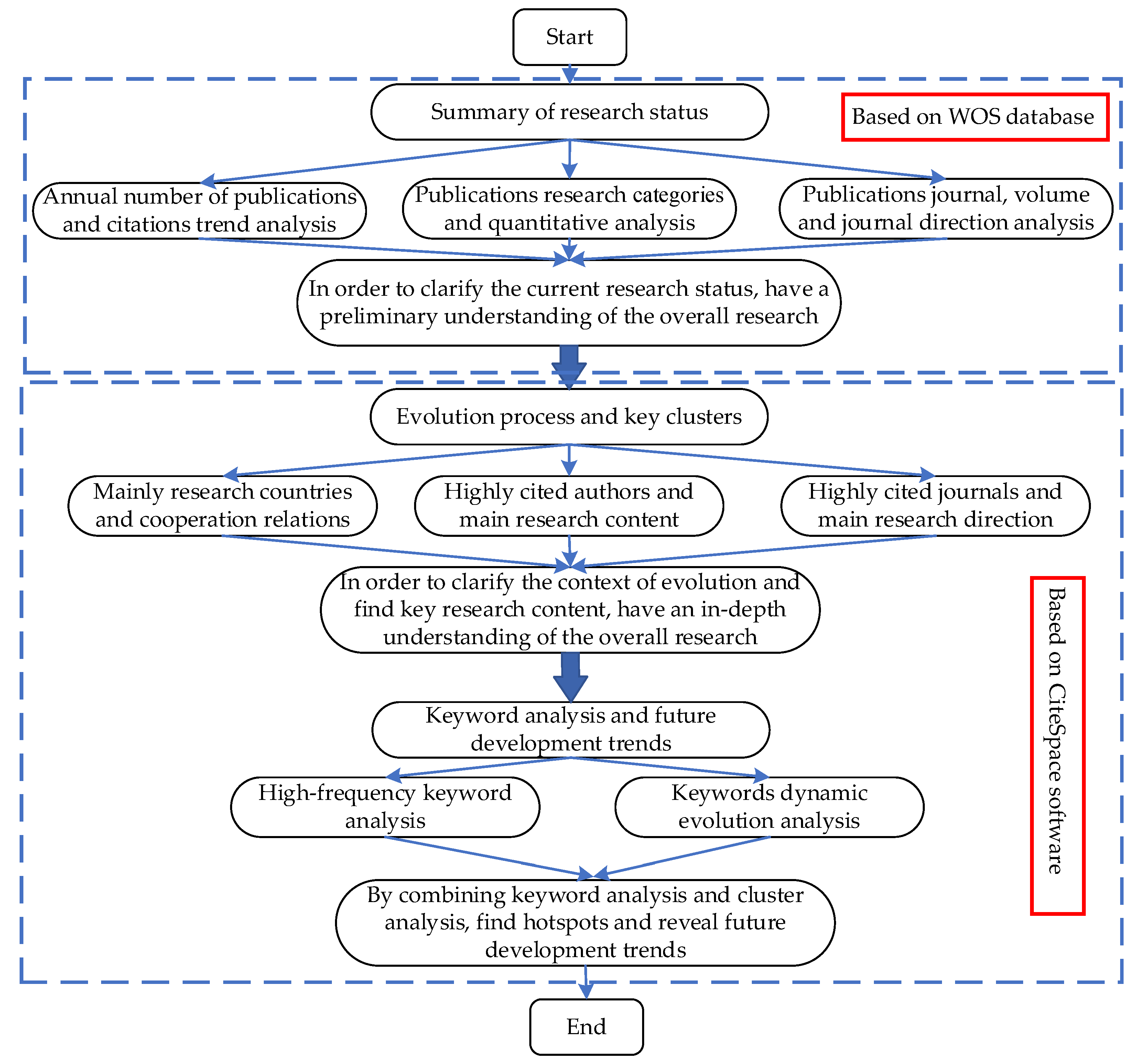
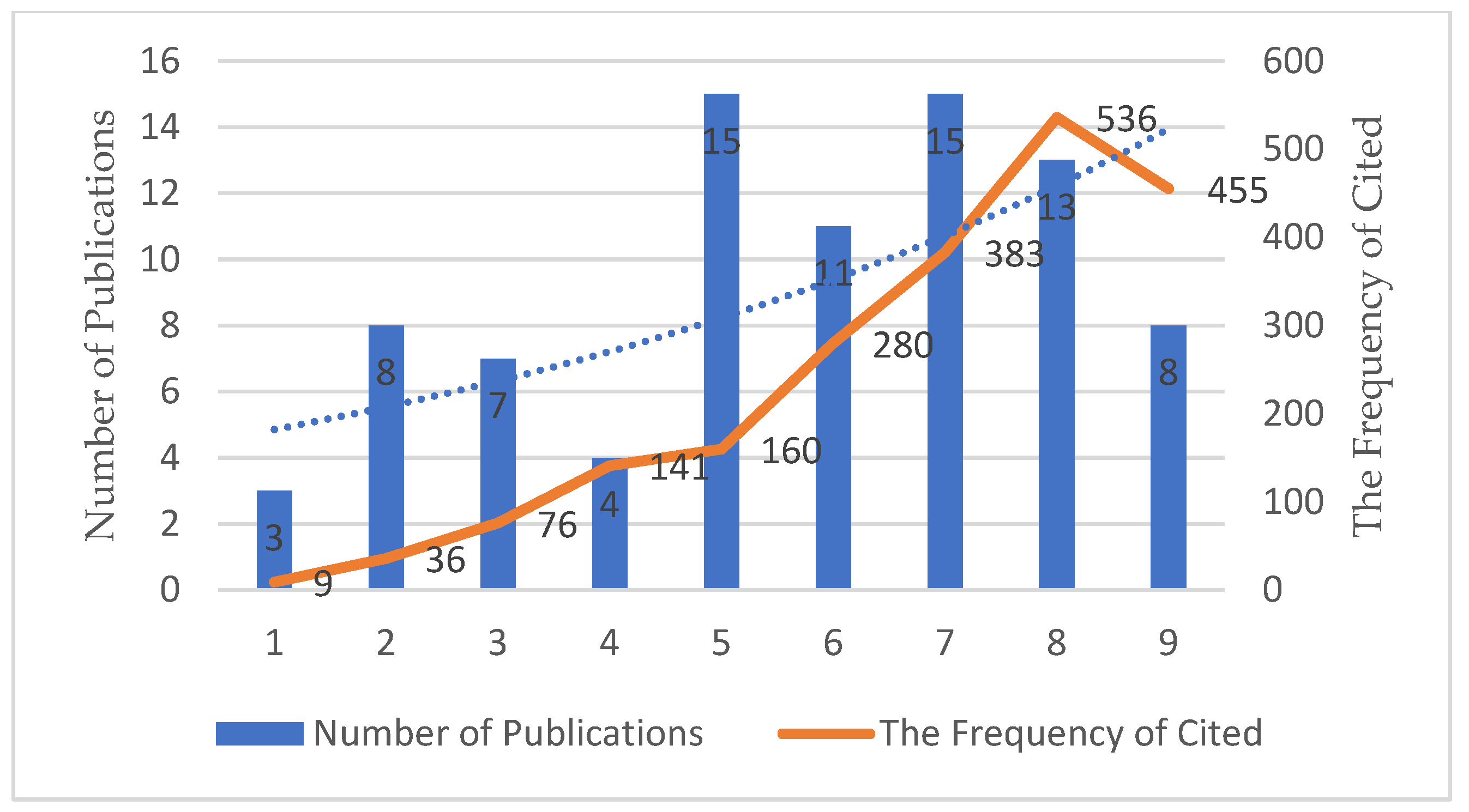
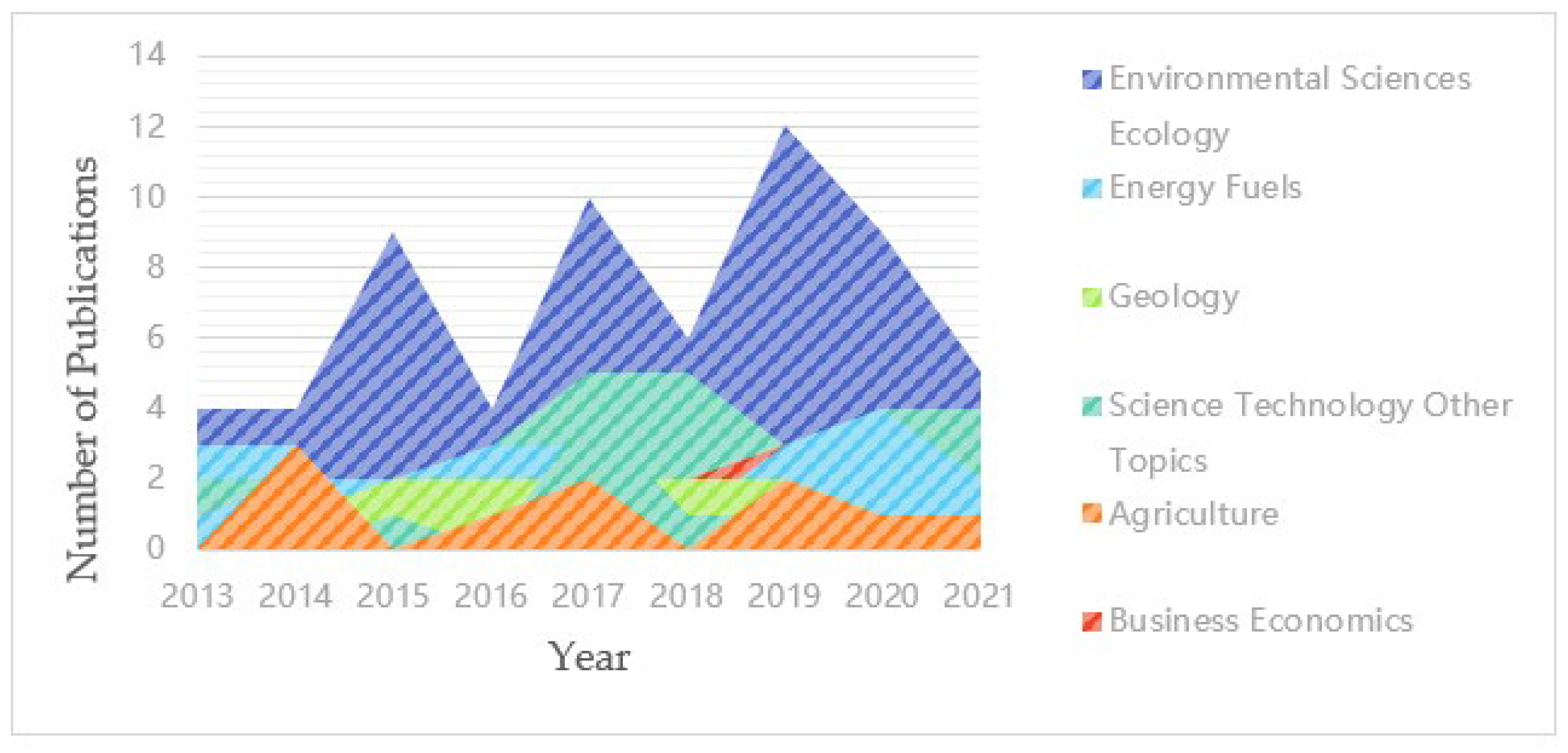
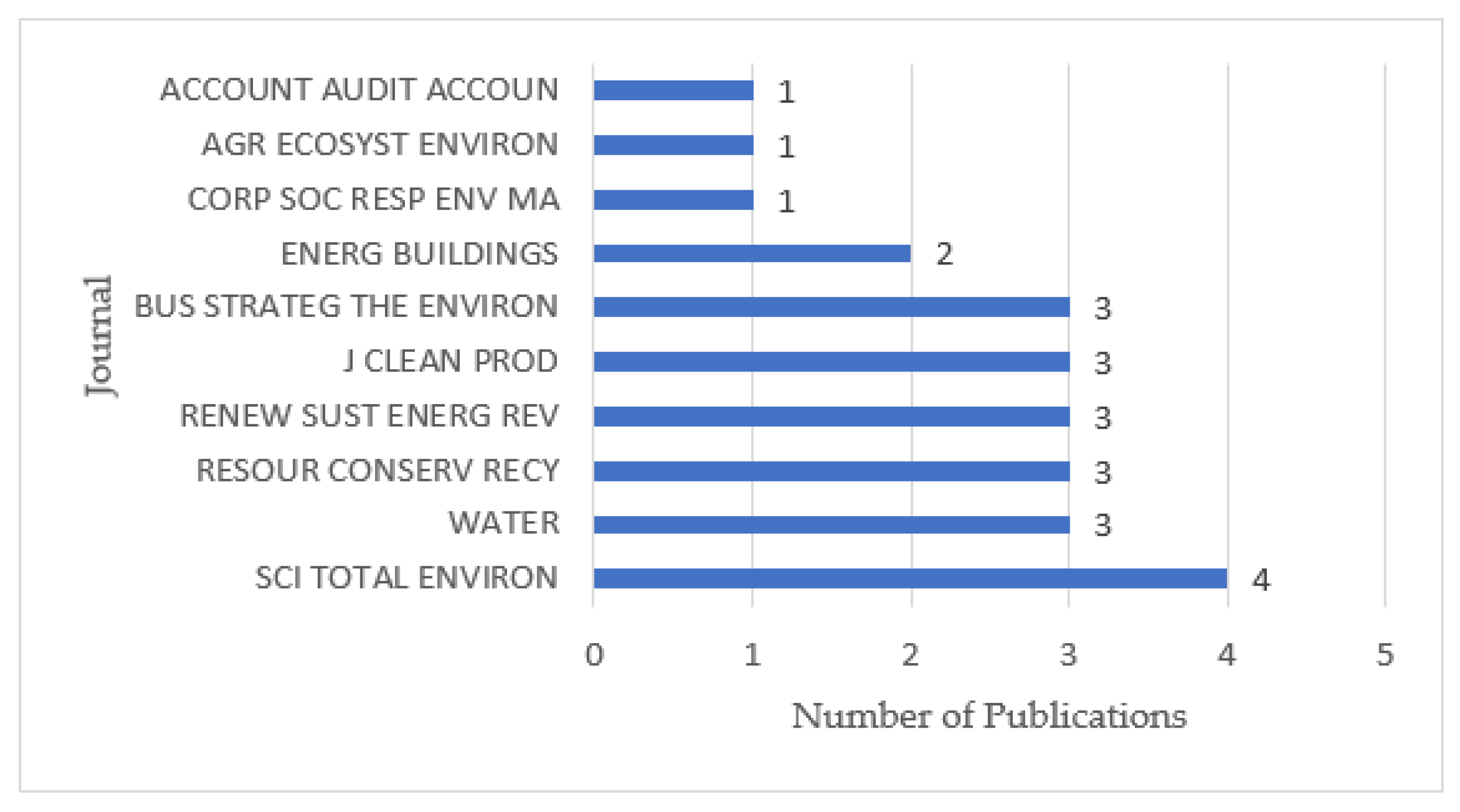
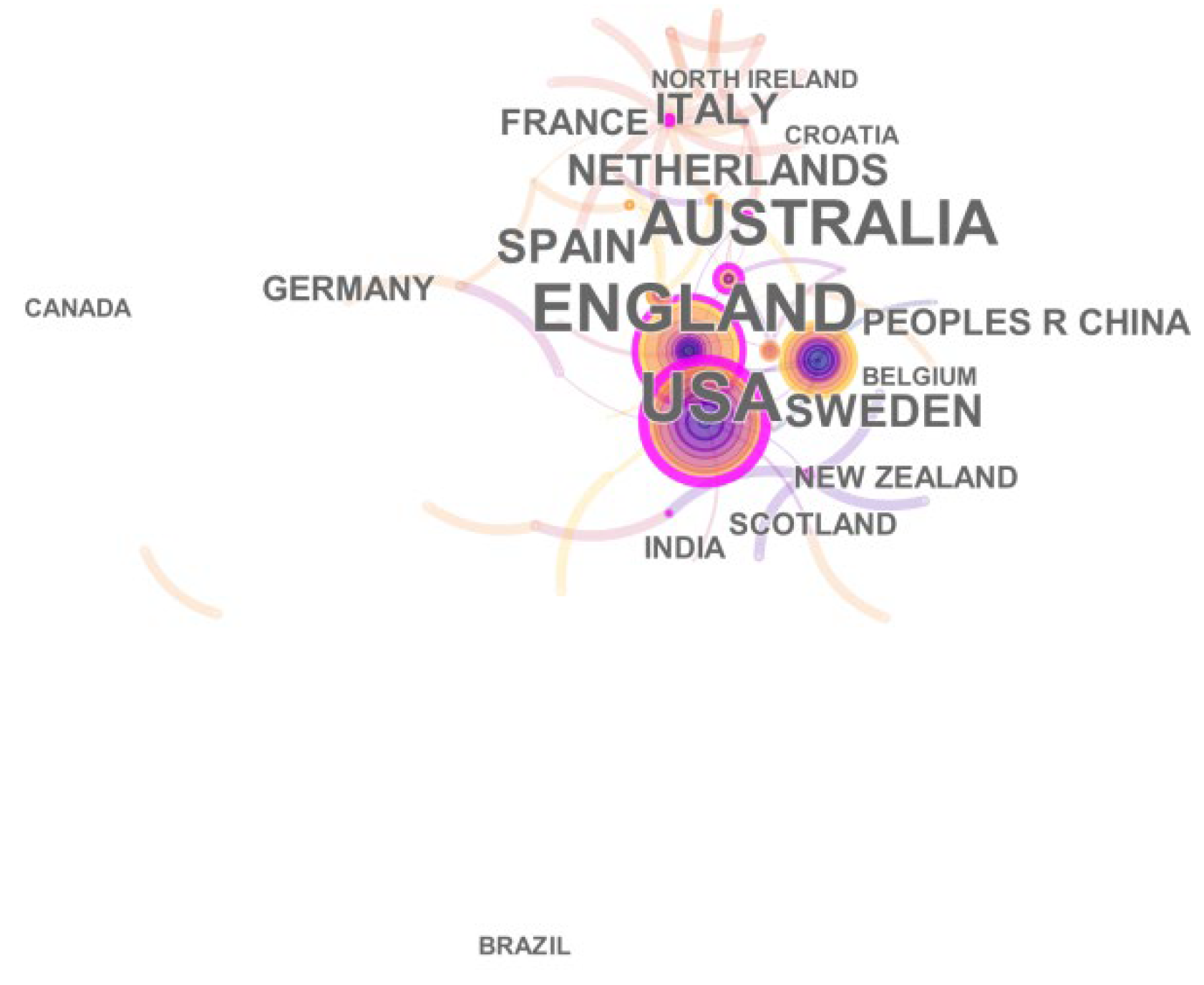
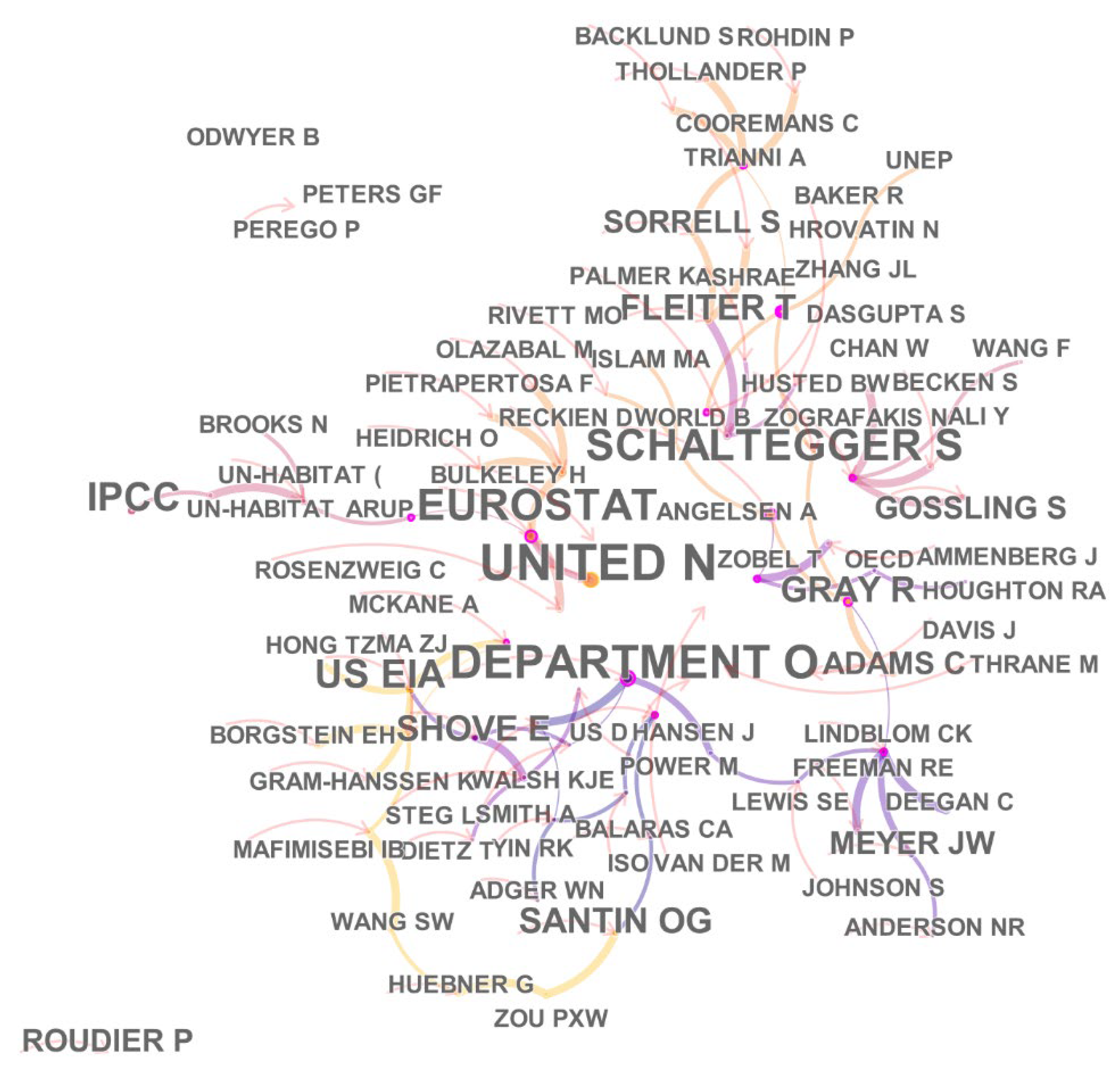
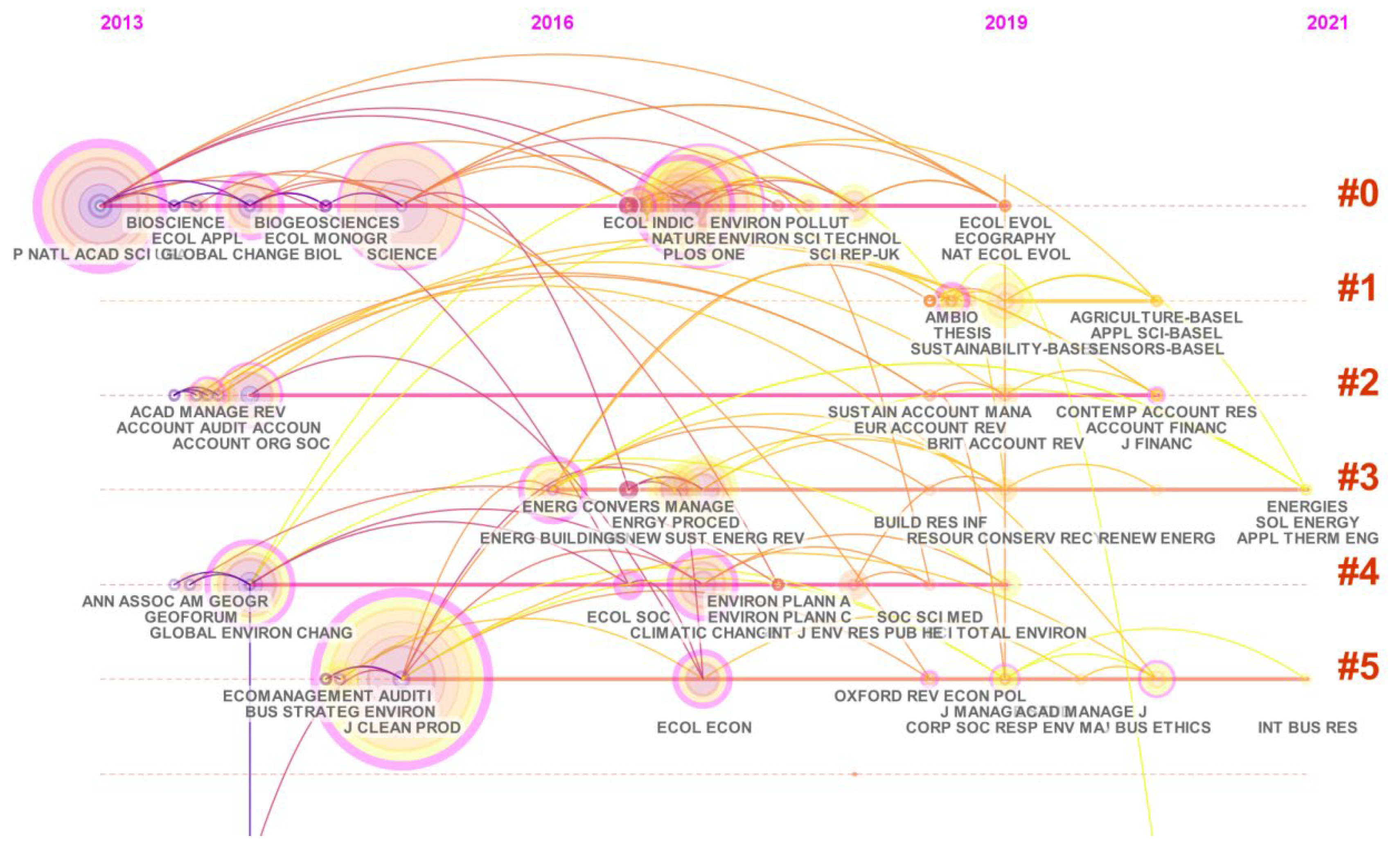
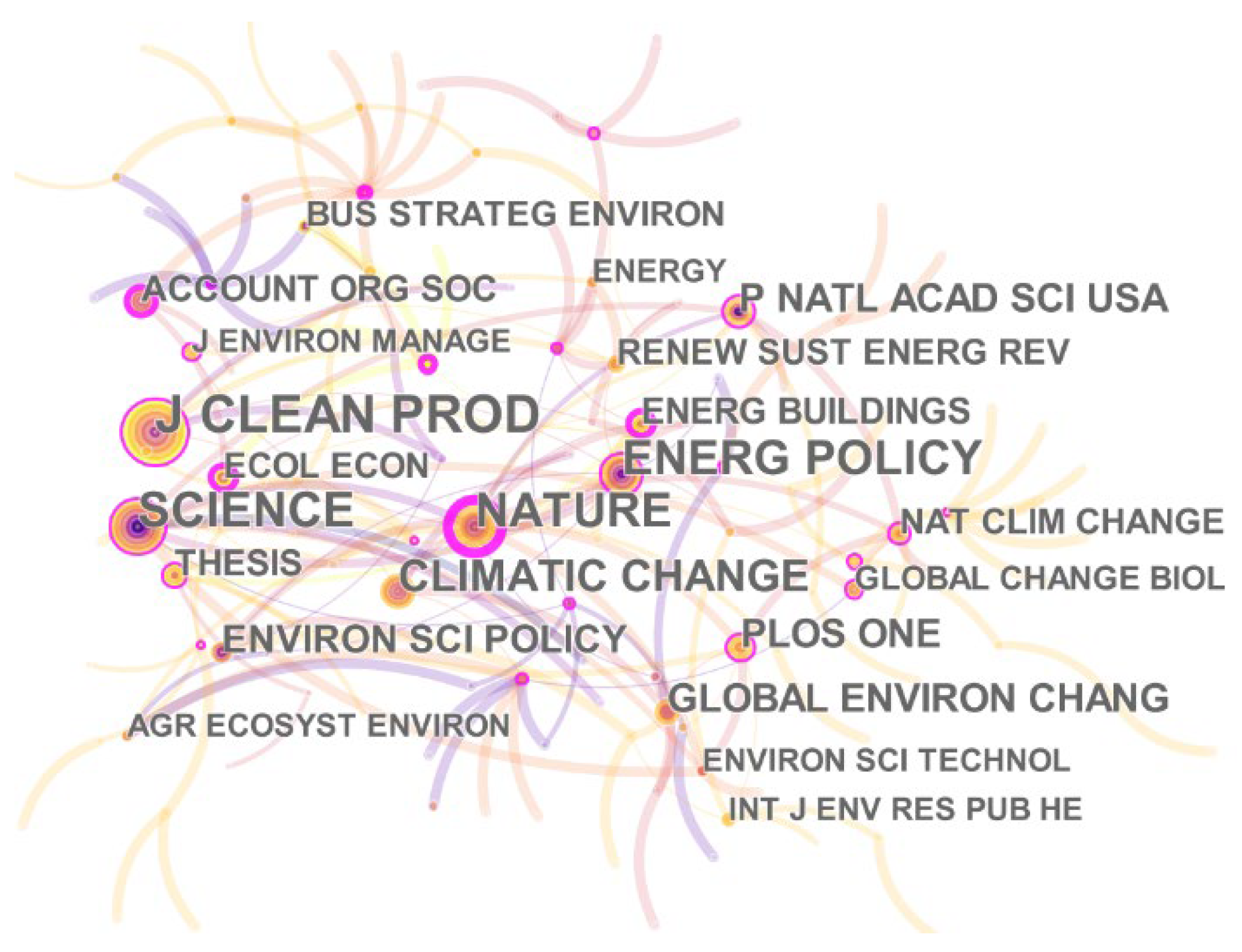
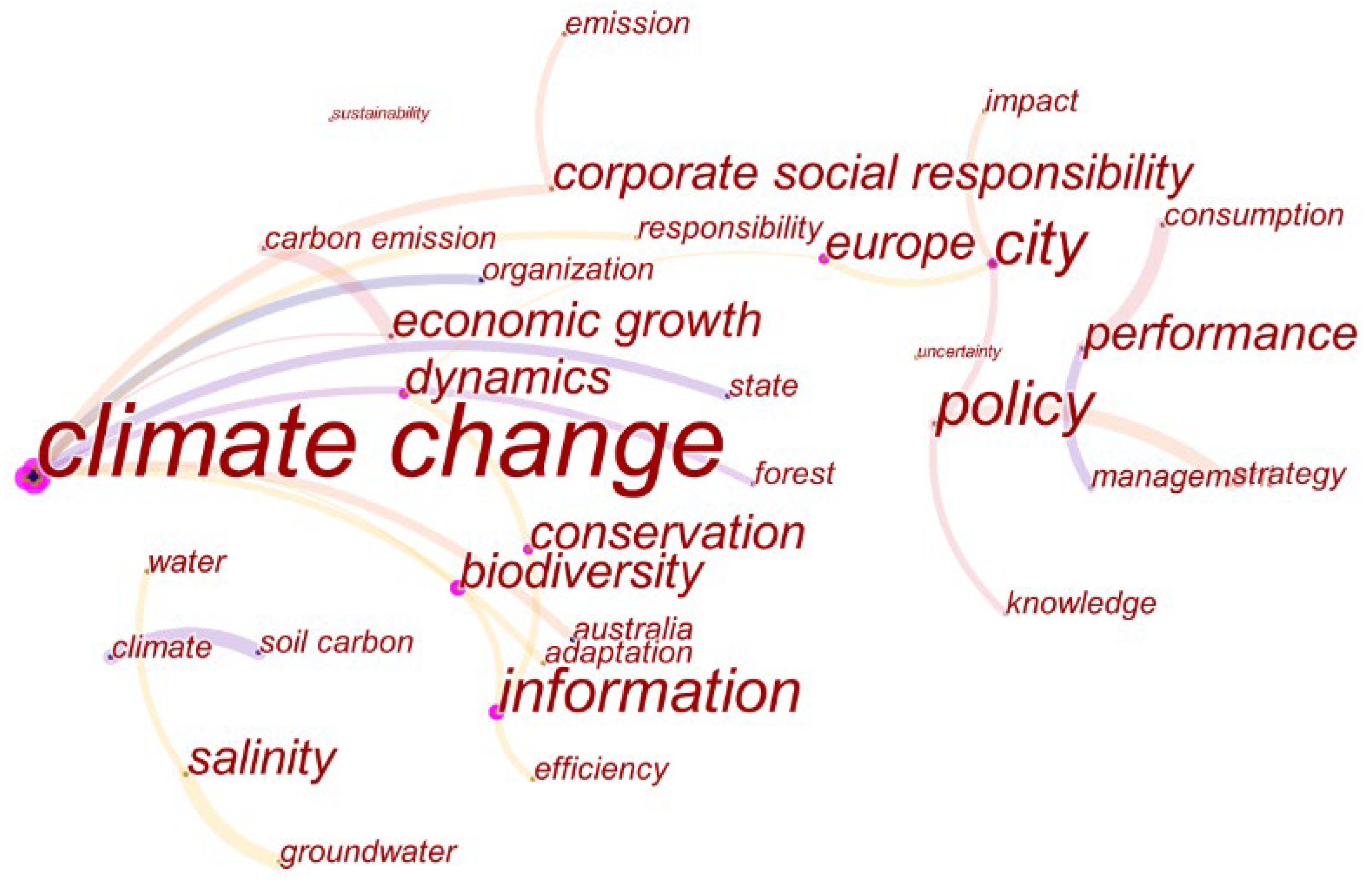
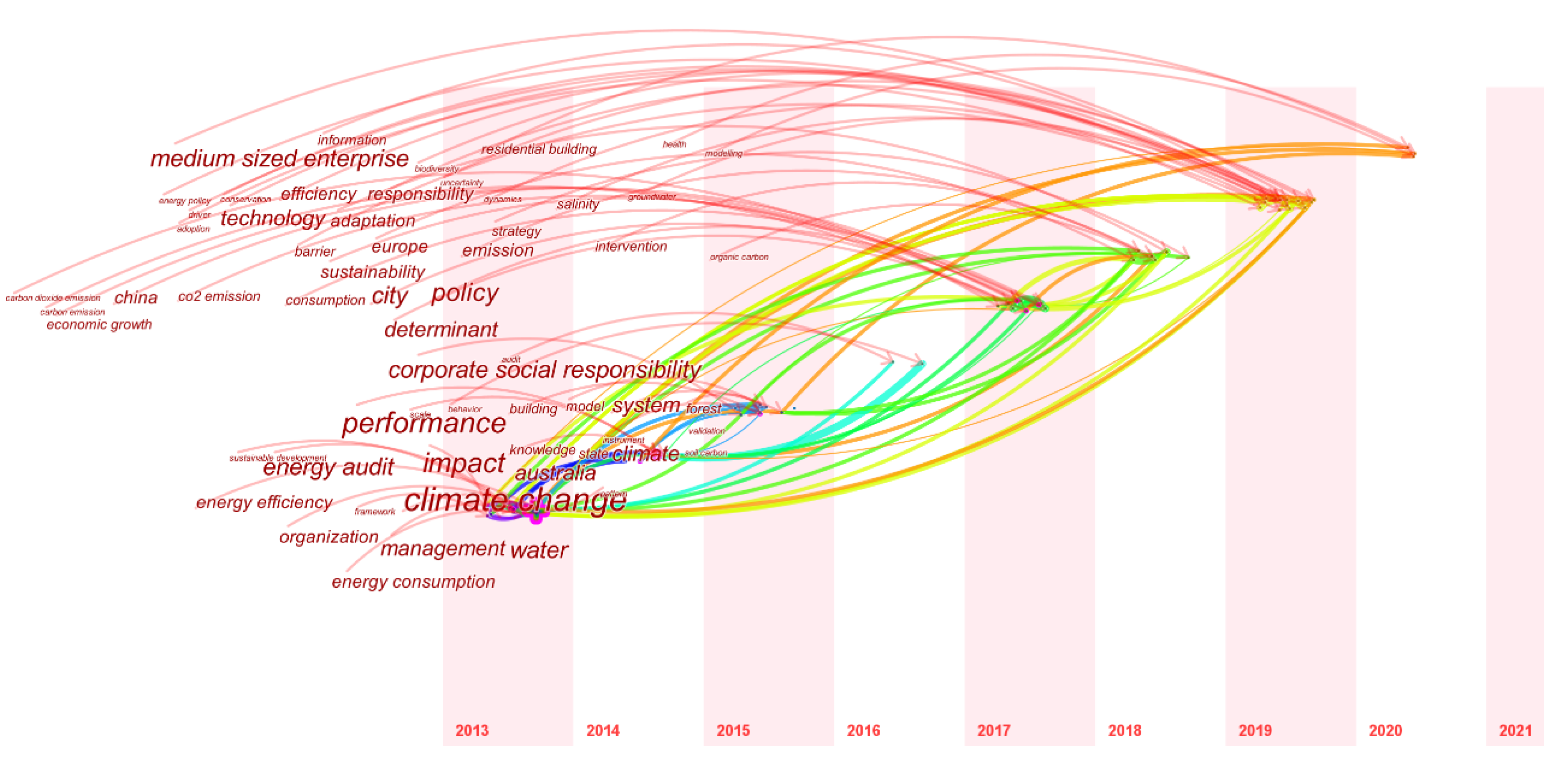
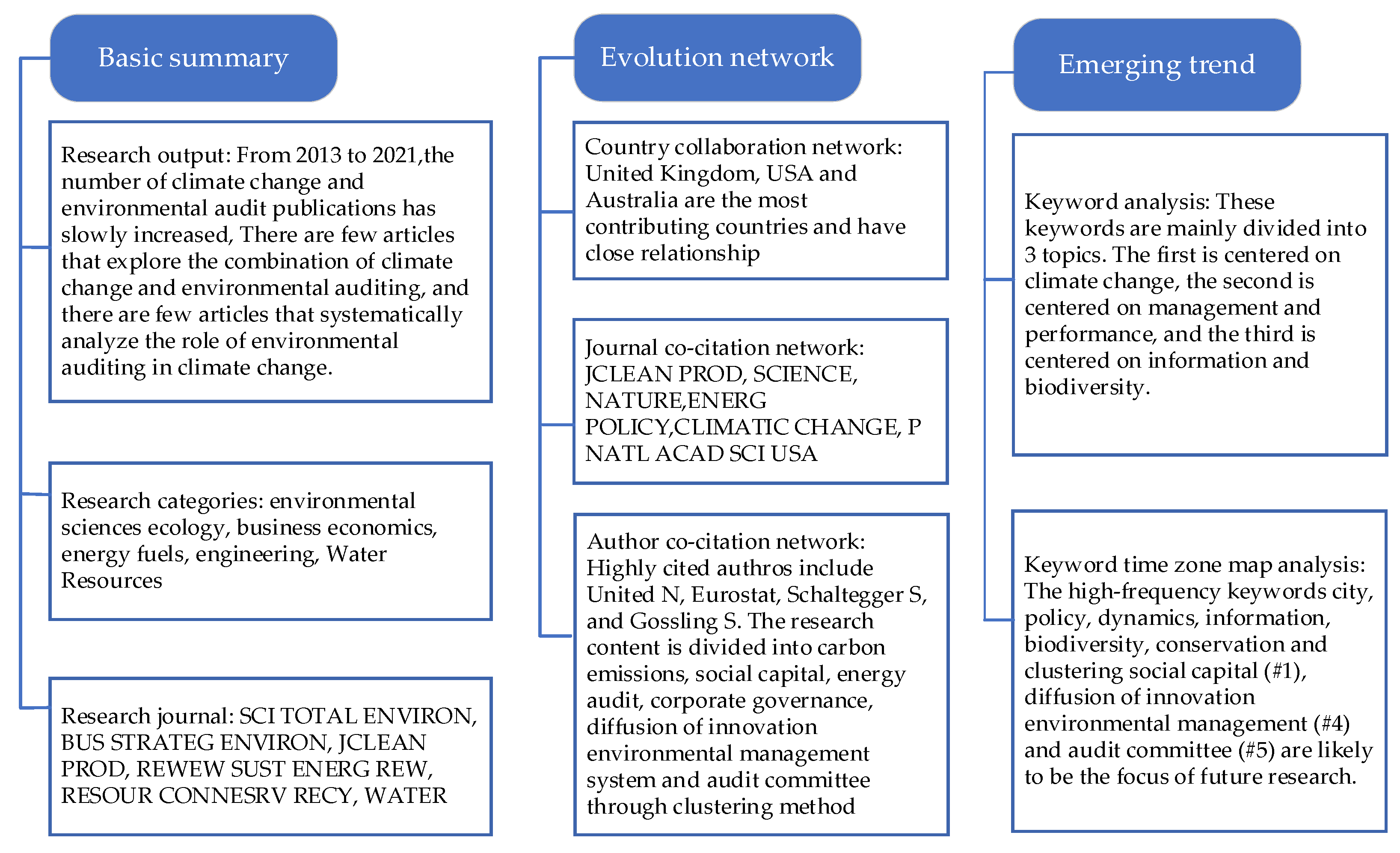
| Frequency | Centrality | Keywords | Frequency | Centrality | Keywords |
|---|---|---|---|---|---|
| 38 | 0.62 | Climate Change | 2 | 0.46 | Biodiversity |
| 6 | 0.24 | Impact | 2 | 0.42 | Conservation |
| 6 | 0.31 | City | 2 | 0.18 | Carbon Emission |
| 4 | 0.17 | Policy | 2 | 0.02 | Strategy |
| 4 | 0.11 | Performance | 2 | 0.00 | Salinity |
| 4 | 0.00 | Management | 2 | 0.00 | Soil Carbon |
| 4 | 0.39 | Dynamics | 2 | 0.00 | Responsibility |
| 4 | 0.12 | Adaptation | 2 | 0.05 | Knowledge |
| 4 | 0.00 | Uncertainty | 2 | 0.09 | Economic Growth |
| 3 | 0.49 | Information | 2 | 0.00 | Supply Chain Management |
| Frequency | Centrality | Countries |
|---|---|---|
| 23 | 0.62 | UK |
| 17 | 0.21 | Australia |
| 14 | 0.21 | USA |
| 5 | 0.08 | Spain |
| 4 | 0.06 | Netherlands |
| 2 | 0.00 | Sweden |
| 2 | 0.00 | Italy |
| 2 | 0.00 | India |
| Frequency | Centrality | Author | Frequency | Centrality | Author |
|---|---|---|---|---|---|
| 6 | 0.05 | United N. | 2 | 0.36 | Zobel T. |
| 4 | 0.12 | Eurostat | 2 | 0.46 | Zografakis N. |
| 4 | 0.28 | Schaltegger S. | 2 | 0.01 | Meyer J.W. |
| 3 | 0.06 | Gossling S. | 2 | 0.08 | Dasgupta S. |
| 3 | 0 | Adams C. | 2 | 0.05 | Husted B.W. |
| Cluster | Periods | Label (LLR) |
|---|---|---|
| #0 | 2013–2019 | Carbon Emissions |
| #1 | 2018–2020 | Social Capital |
| #2 | 2016–2021 | Energy Audit |
| #3 | 2014–2021 | Corporate Governance |
| #4 | 2013–2019 | Diffusion of Innovation Environmental Management System |
| #5 | 2014–2020 | Audit Committee |
| Frequency | Centrality | Cited Journals |
|---|---|---|
| 26 | 0.12 | Journal of Cleaner Production |
| 22 | 0.19 | Science |
| 18 | 0.50 | Nature |
| 18 | 0.15 | Energy Policy |
| 14 | 0.03 | Climatic Change |
| 12 | 0.17 | Proceedings of the National Academy of Sciences of the United States of America |
| 11 | 0.12 | Plos One |
| 11 | 0.05 | Global Environmental Chang-Human and Policy Dimensions |
| 10 | 0.10 | Environmental Science& Policy |
| 9 | 0.24 | Accounting Organizations and Society |
| Count | Year | Keyword | Count | Year | Keyword |
|---|---|---|---|---|---|
| 38 | 2013 | Climate Change | 4 | 2019 | Dynamics |
| 6 | 2016 | Impact | 4 | 2017 | Adaptation |
| 6 | 2017 | City | 4 | 2018 | Uncertainty |
| 4 | 2017 | Policy | 3 | 2014 | Information |
| 4 | 2014 | Performance | 2 | 2019 | Biodiversity |
| 4 | 2014 | Management | 2 | 2019 | Conservation |
Publisher’s Note: MDPI stays neutral with regard to jurisdictional claims in published maps and institutional affiliations. |
© 2022 by the authors. Licensee MDPI, Basel, Switzerland. This article is an open access article distributed under the terms and conditions of the Creative Commons Attribution (CC BY) license (https://creativecommons.org/licenses/by/4.0/).
Share and Cite
Qu, G.; Zhang, Y.; Tan, K.; Han, J.; Qu, W. Exploring Knowledge Domain and Emerging Trends in Climate Change and Environmental Audit: A Scientometric Review. Int. J. Environ. Res. Public Health 2022, 19, 4142. https://doi.org/10.3390/ijerph19074142
Qu G, Zhang Y, Tan K, Han J, Qu W. Exploring Knowledge Domain and Emerging Trends in Climate Change and Environmental Audit: A Scientometric Review. International Journal of Environmental Research and Public Health. 2022; 19(7):4142. https://doi.org/10.3390/ijerph19074142
Chicago/Turabian StyleQu, Guohua, Yue Zhang, Kaichao Tan, Jiangtao Han, and Weihua Qu. 2022. "Exploring Knowledge Domain and Emerging Trends in Climate Change and Environmental Audit: A Scientometric Review" International Journal of Environmental Research and Public Health 19, no. 7: 4142. https://doi.org/10.3390/ijerph19074142
APA StyleQu, G., Zhang, Y., Tan, K., Han, J., & Qu, W. (2022). Exploring Knowledge Domain and Emerging Trends in Climate Change and Environmental Audit: A Scientometric Review. International Journal of Environmental Research and Public Health, 19(7), 4142. https://doi.org/10.3390/ijerph19074142





